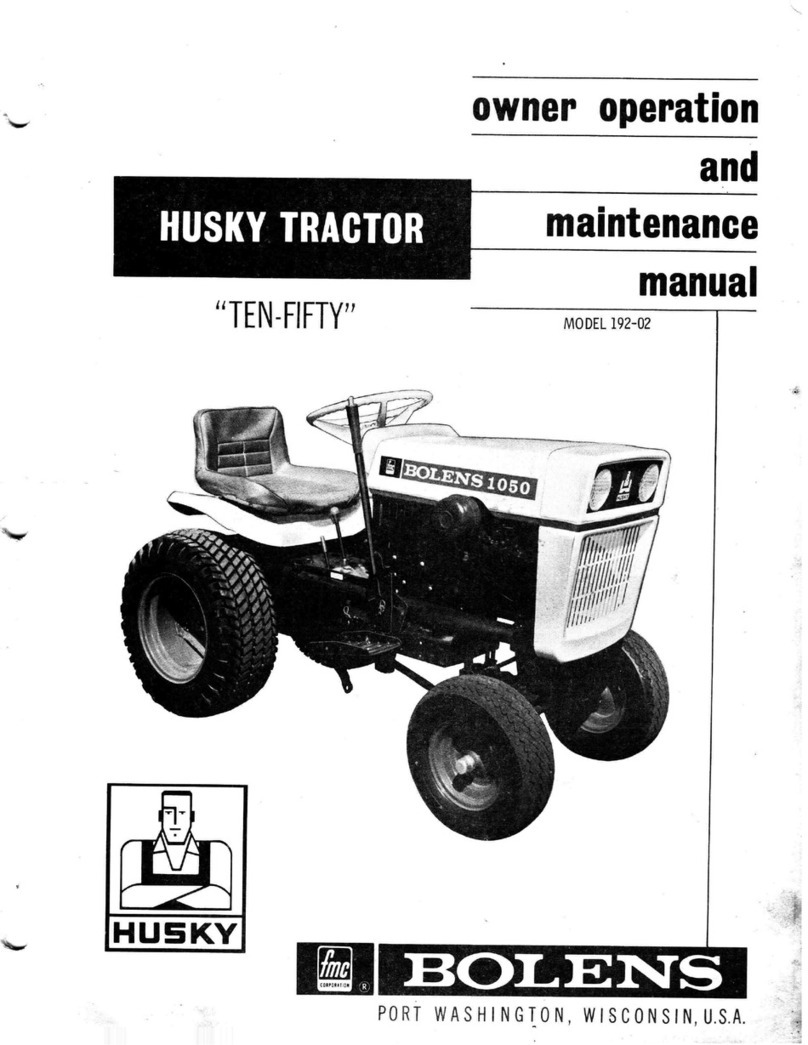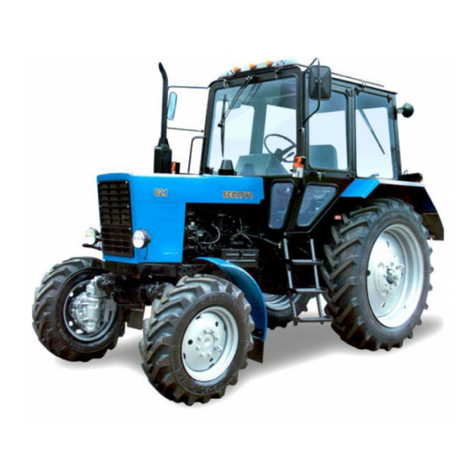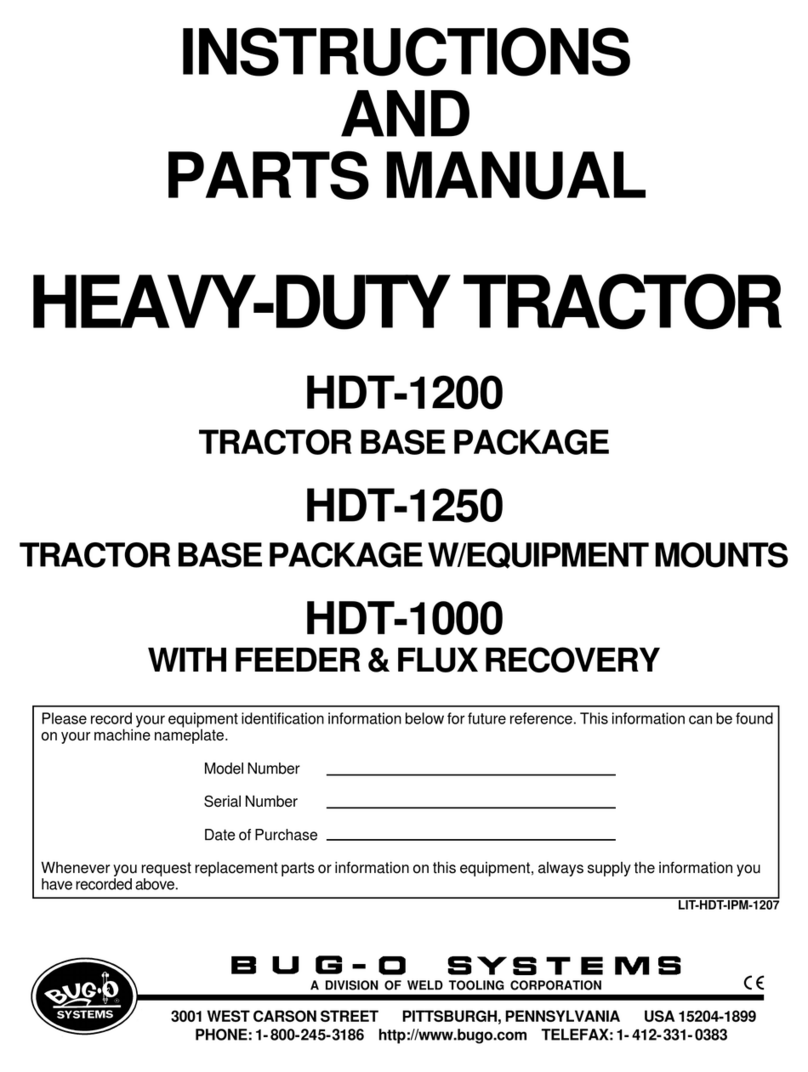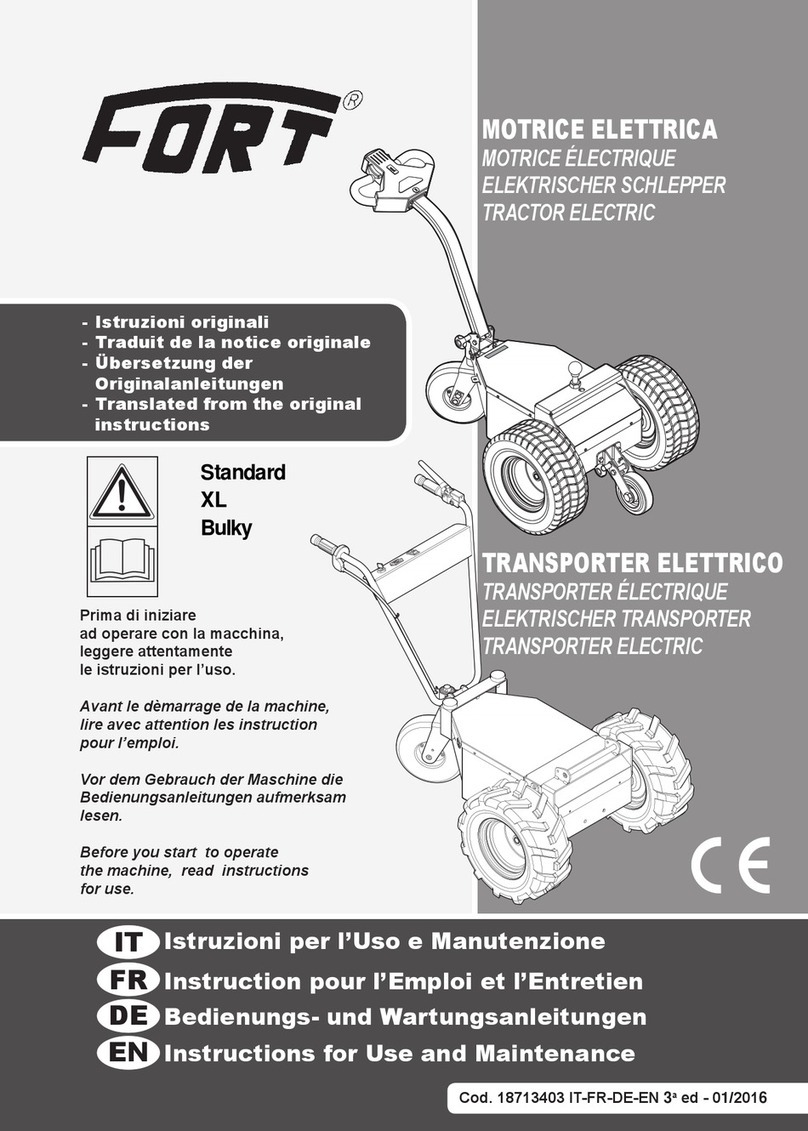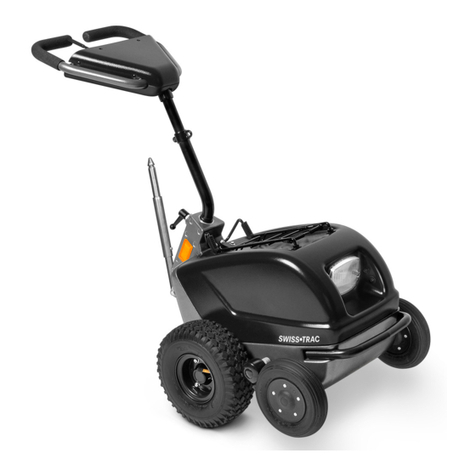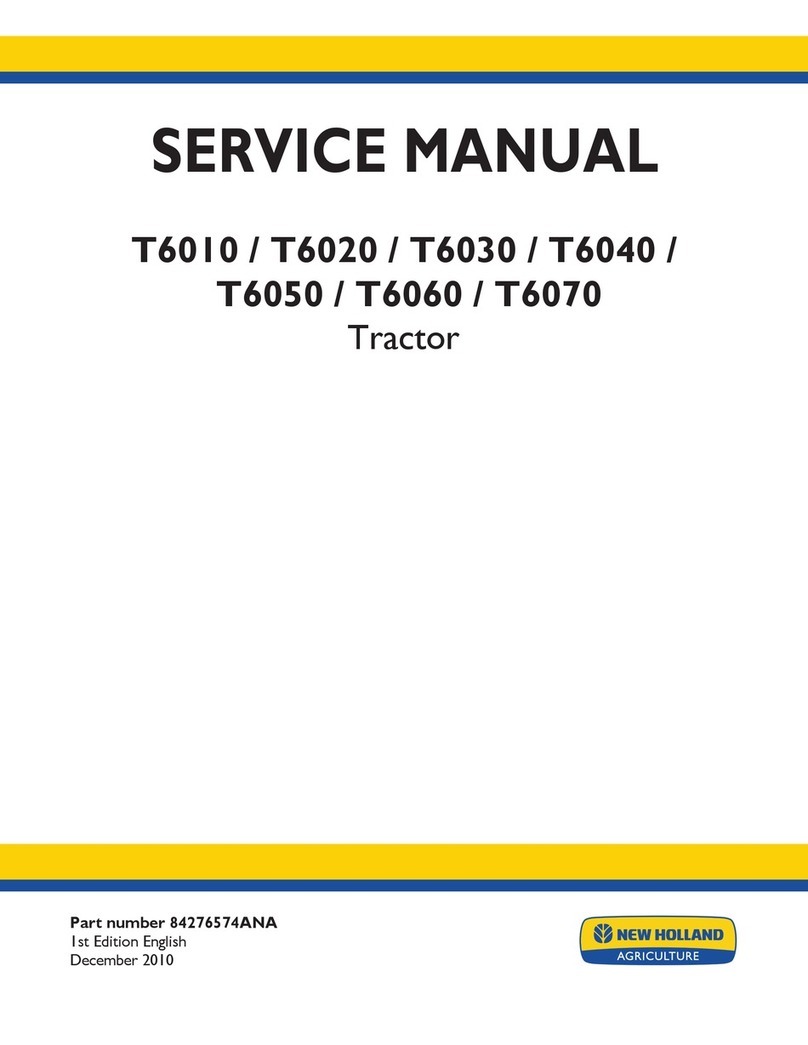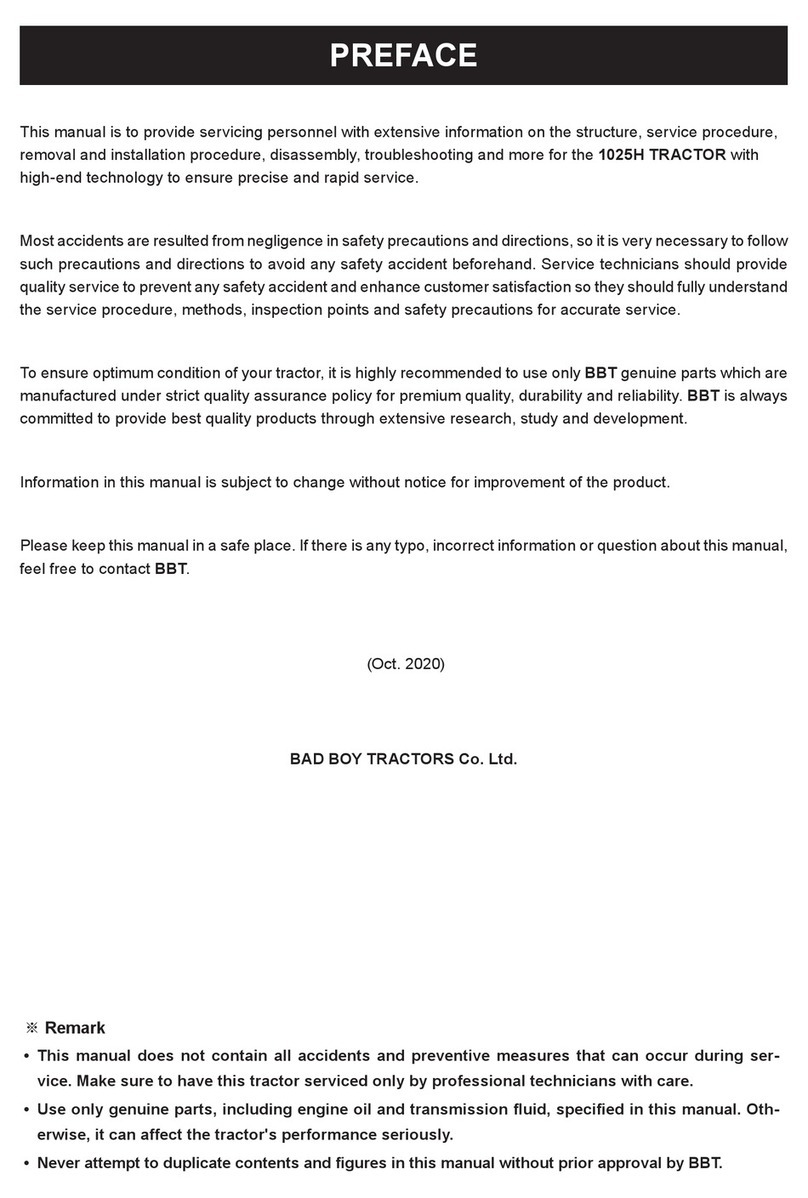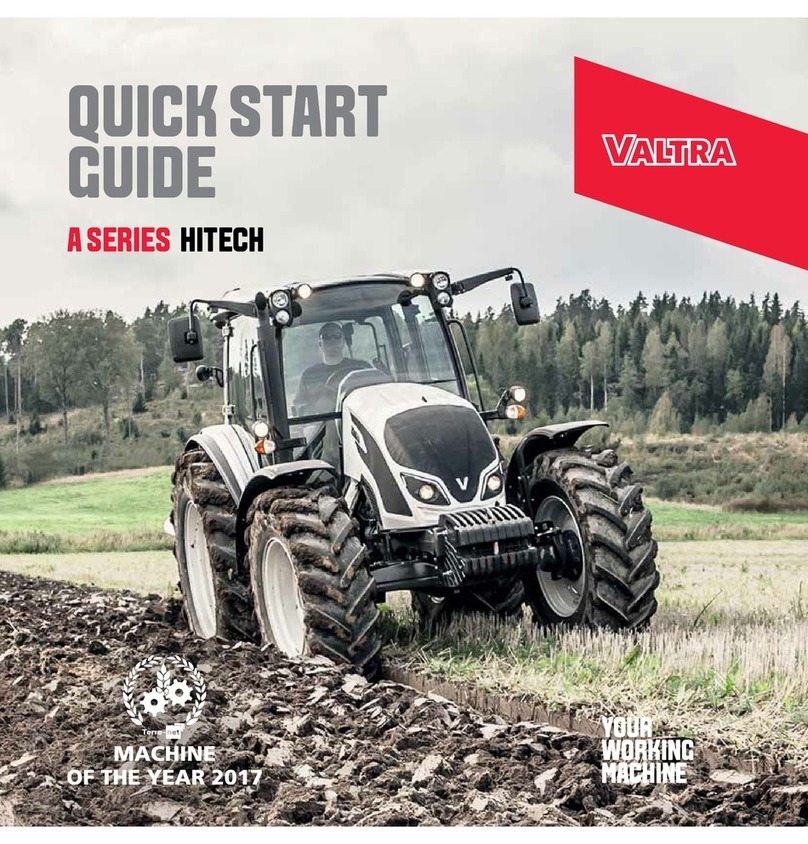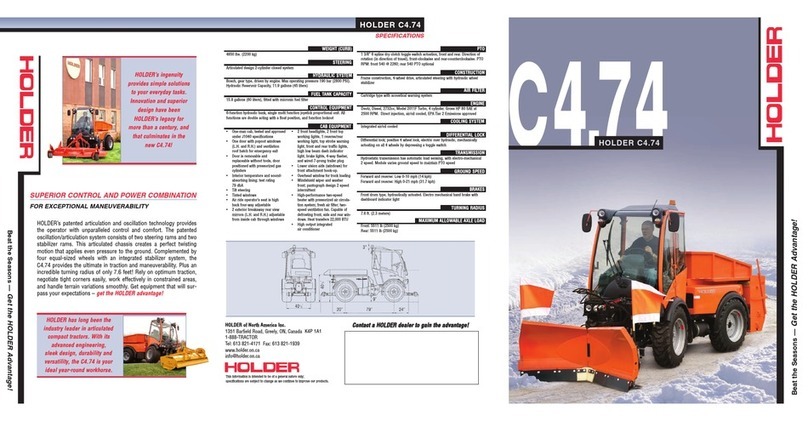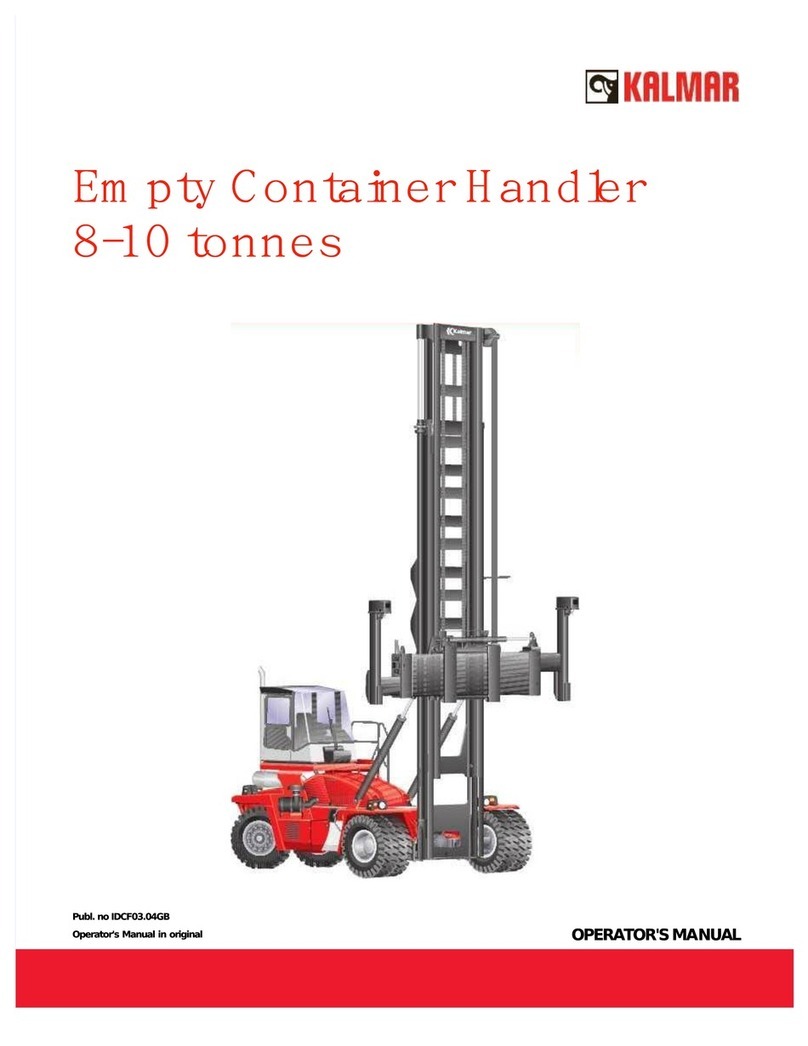Husky 1254-06 User manual


FORM NO. 552533 PRINTED IN U.S.A. 2/72
HUSKY TRACTOR
Model 1254-06
and
TRA-12D WISCONSIN ENGINE
TABLE OF CONTENTS
General Safety Precautions ..................................
Serial Number .......................................................
Specifications ........................................................
Controls .................................................................
Pre-Operational Checks ........................................
Break-In Period .....................................................
Starting the Engine ...............................................
Operation ..............................................................
Preventative Maintenance ....................................
Adjustments ........................................................
Power Take-Off (P.T.O.) ......................................
Maintenance Chart .............................................
Lubrication Chart ................................................
Lubrication ..........................................................
Minor Trouble Shooting Guide ...........................
Wiring Diagram ...................................................
Storing Your Husky Tractor .................................
Page
3
4
4
5
6
6
7
8
9
Page
11
14
15
16
17
17
18
19
PRINTED AT BOLENS 2/72

2
TO THE OWNER
This is an operational and general maintenance manual which does not
attempt to cover major repairs. All major repair work must be per-
formed by an AUTHORIZED DEALER for the factory warranty to be
valid. BOLENS equipment is carefully designed, engineered, and manu-
factured to give good performance if properly operated and maintained.
THE AUTHORIZED DEALER will repair or replace any parts which
fail due to defective material or workmanship during the warranty
period. He will also provide continuing repair service and supply factory
replacement parts.
CONTACT YOUR DEALER FOR ANY REPLACEMENT PARTS OR
SERVICE NEEDED. DO NOT RETURN PARTS DIRECTLY TO THE
FACTORY. THE FACTORY REQUIRES PRIOR APPROVAL ON RE-
TURNS, AND APPROVALS ARE ISSUED ONLY TO BOLENS
DEALERS OR DISTRIBUTORS.
READ YOUR WARRANTY (YELLOW) STATEMENT AND BE SURE
THE POSTPAID WARRANTY REGISTRATION (WHITE) CARD IS
MAILED TO THE FACTORY.

3
Preventing accidents is the responsibility of
every equipment
operator.
The following
general safety precautions must be
fully
understood and followed by every operator of this tractor
and its
attachments.
Review them frequently and NEVER
TAKE CHANCES. BE CAREFUL BEFORE, DURING
AND RIGHT AFTER USE OF ANY POWERED
EQUIPMENT. ACCIDENTS CAN BE
PREVENTED
.
1.
Study your manual. Know your tractor before operating
it. Take time to operate the unit in the safest
manner.
2. Study all
attachment
manuals thoroughly before using
attachments
with tractor. By doing so you will be aware of
both
the
tractor and
attachment
capabilities when used as a
unit and also the safest manner in which to operate
them.
3. Always follow manufacturer's operational suggestions.
4. Do not fill gasoline tank when engine is running or hot.
Add gas (using funnel) only
outdoors
and when engine
is
cool. KEEP SMOKERS AND FLAMES AWAY FROM
UNIT WHILE FUELING.
This
will help eliminate the pos-
sibility of
fi
re and/or
e
x
plosion from spilled gasoline or
fumes.
5. Refuel tractor from
t
he Left side, the side on which the
fuel tank is mounted. This is safer and more convenient
tha
n
reaching
over engine with fuel
can.
6. Store fuel in approved container out of reach of child-
ren. Do not store fuel in the house. Gasoline is highly flam-
mable
and
t
h
e fumes highly
exp
l
osive.
7. Never wear loose clothing when operating unit. Loose
clothing can get caught in moving parts and cause severe in-
juries.
8. Mount vehicle, place transmission shift lever in
NEU-
TRAL, place P
.T.
O
.
l
eve
r
in OFF
position,
depress clutch
pedal
a
nd
set
parking brake prior to starting electric start
engine. This will prevent starting tractor in gear.
9. Do not mount or
l
eave vehicle while it is in motion or in
actual
operation,
nor leave vehicle
unattended
while engine
is
running
.
Injury to the operator or a tractor runaway
could
occur.
1
0. Always shut off engine, place transmission lever
in
NEUTRAL and set parking brake whenever vehicle is to be
left
unattended.
Lower all
attachments
to the ground with
P.T.O. lever in OFF position to prevent injury to by-
s
tan
d
e
rs.
11
.N
ever operate tractor with mower, snow caster, or any
other
attachment
having moving parts, when any child or
another
person is in travel path or discharge area. Children
must not be allowed in or near working areas when equip-
ment is being
used.
Items or objects such as wire,
stones,
small toys and etc. can be ejected at high velocity out of the
discharge chute. Clear work area of all objects which might
be picked up
a
nd
thrown.
12. Always look back to be certain no one
is in the way before using reverse. This
will
avoid the possibility
of
running over
any
children, other persons or pets who might be in the area in
back of the
ve
hicle
.
1
3. Children
shall
not be allowed to operate vehicle at any
time. The average
ch
ild is not capable of coping with the
intricacies
of
operating a power
tool.
14. Do not allow adults to operate vehicle without proper
instructions including all safety
instructions.
In doing so,
you will be sure they know how to operate unit properly
and also are aware of all the safety
precautio
n
s.
15.
Attachments
must be lowered to the ground when stor-
ing tractor. This will prevent the
attachment
from being
dropped accidentally and causing injury. Place P.T.O. lever in
OFF
position.
16. Do not tow vehicle. Damageto the vehicle could
occur.
17. Use care when pulling heavy loads. Use only the ap-
proved draw bar
h
i
tc
h
.
18.
Do not carry
p
asse
nger
s
.
The passengers could fall off
the
vehicle
and be
inj
ured
.
19. Keep tractor
a
nd
attachments
free of excess grease and
oil. The unit will operate cooler, be easier to
mai
ntain, and
safer
to
operate.
20. Engine must be stopped, and P.T.O. disengaged when
cleaning,
ser
v
i
ci
ng,
adjusting, repairing, or installing
a
ttach
·
ments on tractor. This is necessary to avoid possible injury
from moving
parts.
21. Always disconnect negative (-) battery cable from
battery before doing any work on the electrical system.
Reconnect it LAST when work is done. This is
to
prevent
shorting of electrical system and accidental
burns.
22. Before starting unit check to be sure all guards and
safety devices are in place and in working condition and
P.T.O. is in OFF position. This will help assure you against
possible
injury.
23. Do not drive this unit on a public thoroughfare at any
time. The operator is risking injury from passing vehicles.
Most
l
ocal ordinances prohibit operating a
un
i
t
such as this
on a
pub
l
ic
thoroughfare.
24. Do not drive too close to a creek or ditch, also be alert
for holes and other hazards. If you would drive into any of
the
above
you
could lose control of the
unit.
25. Be carefu
l
on slopes, reduce speed and avoid sharp
turns to prevent tipping or loss of control. Do not stop or
start
suddenly
when going uphill or
downhill.
26. Do not start or operate vehicle in an inside area, unless
area is adequately ventilated. Engine exhaust contains
carbo
n
monoxide
fu
mes, which are very
poisonous.
27. Do not operate
attachments
when transporting
vehicle
.
28.
A
lways wear substa
nti
al footwear to provide as
m
u
ch
protection as possible.
GENERAL SAFETY PRECAUTIONS

4
To ensure prompt service when repairs or adjustments are
required, your Bolens Dealer must have the following infor-
mation. For your own personal reference, fill in the serial number
spaces provided below.
1. Model number of tractor (Fig. 1) 1254-06
2. Serial number of tractor (Fig. 1)
Figure 1
BOLENS RESERVES THE RIGHT TO MAKE CHANGES
OR IMPROVEMENTS TO ITS PRODUCTS WITHOUT
OBLIGATION TO INSTALL SAME ON PRODUCTS
PREVIOUSLY MANUFACTURED.
Engine ............................................ Wisconsin 12 HP at 3600 RPM
Engine Type ............................................................. 4-Cycle, single
cylinder, air cooled
Fuel Capacity ....................................................................... 5 quarts
Oil Capacity............................................................................ 1 quart
Air Cleaner ......................................................................... Dry type
Drive ......................................................... Geared transmission and
controlled differential (Transaxle)
Speed .......................................................... 3 forward and 1 reverse
(All speeds are in two ranges for a total
approximate) of 6 forward and 2 reverse.
Lowest speed: less than
3/4 mph. Highest speed:
6mph.
3. Model number of engine (Fig. 2) TRA12D
4. Serial number of engine (Fig. 2)
5. Spec. number of engine (Fig. 2)
Figure 2
Power to Attachments ............................... Farm tractor type (PTO)
direct drive with universal
joints and splined shaft.
Tires .............................................................. Extra-wide terra-tires.
Front: 16 x 6.50-8. Rear:
23 x 10.50-12. With lawn and
garden tread.
Height ................................................................................ 40 inches
Width ................................................................................. 34 inches
Length ................................................................................ 63 inches
Wheelbase ......................................................................... 43 inches
Turning Radius .................................................................. 40 inches
Ground Clearance ............................................................... 7 inches
Shipping Weight ............................................................ 675 pounds
Standard equipment .......................................... P.T.O. splined shaft
to drive front, center or rear attachments; electric
starting; 45 amp battery; controlled differential;
two speed ranges; lights. Interlock switches to
prevent tractor from being started with P.T.O.
lever in ON position and clutch engaged; coil
ignition; ammeter.
SERIAL NUMBER
SPECIFICATIONS

5
Before operating the tractor, the operator should become
familiar with the function and location of each control to
ensure proper and efficient operation.
The following listed numbers and accompanying informa-
tion correspond to those numbers assigned to the controls
indicated in Figure 3.
Figure 3
1. CHOKE.
Choke lever UP towards the "ON" position closes choke for
starting. Choke lever DOWN to "OFF" position opens
choke for operation.
2. AMMETER.
Indicates rate of charge to or discharge from battery.
3. IGNITION-STARTER SWITCH.
Turn ignition key to the right to start engine. Release when
engine starts.
4. THROTTLE.
Move throttle lever "UP" one-half way for starting.
5. CLUTCH / BRAKE PEDAL.
To shift gears, depress clutch pedal fully. This disengages
the clutch, and fully applies brake.
6. GEAR SHIFT LEVER.
For selection of 1st, 2nd, 3rd and reverse gear.
7. TWO SPEED RANGE LEVER.
High and low range. Provides a range of 6 speeds ahead, 2 in
reverse.
8. P.T.O. (POWER TAKE OFF) CLUTCH.
Push forward to engage and pull back to disengage power to
attachments.
9. PARKING BRAKE.
To apply parking brake, pull knob up and move it to the
right. To release pull knob up and move it to the left.
10. ATTACHMENT LIFT LEVER.
When adjusting height of attachments, push thumb button
on top of lift lever to unlock. Six positions available.
11 . LIGHT SWITCH.
Pull switch knob out to turn on lights, push in to turn lights
off.
CONTROLS
LOCATION & FUNCTION

6
The operator should become familiar with the following
pre-operational check list, and perform each check prior to
starting or operating the Husky. REFER TO PREVENTIVE
MAINTENANCE SECTION OF MANUAL, page 9, for
details.
1. Check for proper level of engine oil. Fill crankcase
through dipstick opening. The oil level is indicated by
marks on the dipstick. See Figure 4.
2. Check gasoline tank for sufficient gas supply. Use a good
grade of clean regular gasoline.
KEEP SMOKERS AND FLAMES AWAY
WHEN REFUELING. BE CAREFUL NOT
TO SHORT FUEL CAN ON ELECTRICAL
CONNECTIONS.
Figure 4
Breaking in a new engine, in the proper manner, will greatly
increase its life.
There is no quick way to force the establishment of good
bearing surfaces, and these can only be obtained by running
a new engine carefully and under reduced speeds and loads
for a short period of time.
Run the engine for an hour without load, at 1/2 throttle.
The speed should then be increased gradually to engine op-
erating speed, still without load, for an additional two
hours. If at all possible, operate the engine at light loads for
a period totalling about eight hours, before maximum load
is applied.
3. Inspect battery for:
A. Proper electrolyte level.
B. Clean cables of dirt and corrosion.
C. Clean terminals of dirt and corrosion.
Refer to Figure 5 for battery and its location.
Figure 5
4. Check to see that air cleaner element is free of debris.
Clean regularly. Refer to Figure 5 and Preventive Mainte-
nance, page 9.
5. Check flywheel screen for debris, and clean regularly.
Refer to Figure 5.
6. Visually check for loose or missing nuts, screws, and
damaged parts. Replace and tighten before starting engine.
7. Check for even tire inflation. FRONT AND REAR
TIRE INFLATION SHOULD NOT BE LESS THAN 8 LBS.
NOR MORE THAN 12.
NOTE: AFTER RUN-IN OF NEW ENGINES, USE OIL
RECOMMENDED IN LUBRICATION CHART.
(Page 16.)
The engine oil level must be maintained in the "safe" oper-
ating range at all times. Oil level must be between the L
(low) and F (full) marks on the dipstick. Always clean area
around dipstick so that dirt does not fall into engine when
dipstick is removed. Check daily and add oil as necessary to
maintain proper level - DO NOT OVERFILL.
On a new engine, change oil after the first 2 hours and
thereafter at 50 hour intervals. Drain oil (Figure 26) while
it is hot for it will then flow more freely and thus carry
away more impurities.
PRE-OPERATIONAL CHECKS
BREAK-IN PERIOD

7
Figure 6
NORMAL STARTING
1. THE ENGINE WILL START ONLY WHEN P.T.O.
CONTROL LEVER IS IN "OFF" POSITION AND THE
CLUTCH/BRAKE PEDAL IS FULLY DEPRESSED.
2. Move choke lever all the way up (choke on). Experience
will indicate need for more or less choking due to variations
in temperature, grade of fuel, etc.
3. Move throttle lever up about half-way.
4. Insert ignition key and turn to the right to start engine.
Release when engine starts.
LIMIT CRANKING (CONTINUOUS) TO A
PERIOD OF 30 SECONDS TO PREVENT
OVERHEATING OF THE STARTER. IF
CRANKED FOR 30 SECONDS, STARTER
SHOULD NOT BE OPERATED AGAIN FOR 60
SECONDS TO ALLOW TIME FOR COOLING.
5. Move choke lever down about halfway as soon as engine
starts. Gradually push all the way down as the engine
warms up. In normal operation, choke lever must be in off
(down) position for best engine efficiency and fuel
economy.
6. Move throttle lever up to full speed when operating
tractor.
7. To stop engine, turn key OFF (counterclockwise) and
place gear shift lever in NEUTRAL and set brake. Remove the
ignition key when the tractor is not in use, or left unattended.
If engine has been working hard let it idle several minutes
before shutting it off. This will allow engine temperatures to
normalize more rapidly, preventing overheating.
EMERGENCY STARTING
In the event of electrical failure, get in touch with your
DEALER for assistance in locating the trouble.
Should the battery be too low on power to start the unit, it
is always best to remove the battery and have it recharged.
1. Check P.T.O. lever (must be in OFF position), gear shift
(must be in NEUTRAL) and parking brake set.
2. When starting manually with a rope, remove "V" belt
from starter and engine pulley.
3. Wind the starter rope clockwise around the engine
starter pulley. See arrow Figure 7. Give a quick, steady pull
on the starter rope. Repeat if necessary, until engine starts.
Figure 7
STOP ENGINE BEFORE REINSTALLING
STARTER-GENERATOR BELT.
NOTE: Should jumper cables be used instead of a rope
start, the following must be observed:
4. REMOVE CELL CAPS.
5. Connect ends of one cable to positive (+) terminal of
each battery. Connect one end of other cable to negative (-)
of "good" battery. Connect other end of cable to engine
block on vehicle being started. (NOT TO NEGATIVE TER-
MINAL OF BATTERY.)
6. Follow procedure outlined under Normal Starting.
7. Remove tractor battery and have it fully charged as soon
as possible.
8. After the battery is fully recharged and has been
checked, reinstall it in the tractor, connecting the ground
cable last.
STARTING THE ENGINE

8
BEFORE DRIVING THE HUSKY, THE OPERATOR
SHOULD BE FAMILIAR WITH THE LOCATION AND
FUNCTIONS OF ALL CONTROLS. REMEMBER: THE
ENGINE WILL START ONLY WHEN P.T.O. LEVER IS
IN OFF POSITION AND THE CLUTCH/BRAKE PEDAL
IS FULLY DEPRESSED.
THREE-SPEED TRANSMISSION
The HUSKY features a 3-speed geared transmission plus a
second range to give you a wide choice of operating speeds.
NOTE: TO PREVENT DAMAGE TO THE GEARS, DO
NOT SHIFT GEARS WHILE THE TRACTOR IS
IN MOTION. TRACTOR MUST BE AT A FULL
STOP. AVOID CLASHING GEARS WHEN
SHIFTING. LOW speed range is best for heavy jobs
such as tilling, plowing, snow casting or mowing
tall or lush grass.
The High-Low speed range change lever is located on the
transmission cover just to the right of the shift lever. To
change range, depress the clutch, bring tractor to a FULL
STOP and move lever forward to place in low range, back
to place in high range - as directed on instruction plate
adjacent to lever.
GEAR
LOW SPEED
RANGE*
HIGH SPEED
RANGE*
1st
3/4 mph
2 mph
2nd
1-1/4 mph
3-1/2 mph
3rd
2 mph
6 mph
*Approximate speed at full throttle adjustment. The speed
will decrease in each gear as the throttle is adjusted toward
idle. Speeds will also vary depending on road or ground
condition and load attached to tractor.
NOTE: ALWAYS START OUT IN THE GEAR IN WHICH
YOU INTEND TO DRIVE OR OPERATE. IF
YOU WISH TO CHANGE GEARS - BRING THE
TRACTOR TO A FULL STOP. DO NOT SHIFT
GEARS WHILE TRACTOR IS IN MOTION!
CONTROLLED DIFFERENTIAL
By turning the control knob, located on the hub of the left
rear wheel as shown in Figure 8, you can vary the degree of
differential traction up to nearly straight axle drive. For
"heavy" jobs such as plowing or snow casting, turn the
knob clockwise (as viewed from left side of tractor, facing
end of axle) until desired degree of drive to both wheels is
obtained. For mowing or other " light" jobs, be sure to have
control knob in standard differential position (that is, turn
the control knob counterclockwise until it stops). This is
necessary to avoid gouging or scuffing, which would be
caused by having both wheels driving on turns.
Figure 8
DO NOT ADJUST CONTROL KNOB
WHILE TRACTOR IS IN MOTION. NEVER
T I G HT E N W I T H A W R E N CH OR
HAMMER.
Figure 9
ATTACHMENT LIFT LEVER
Height of attachments can be varied through 6 positions
with the attachment lift lever. To unlock lever, push thumb
button release knob on top.
Power take-off (P.T.O.) lever move to "ON" to engage and
to "OFF" to disengage power to attachments. Always be
sure to lock lever in slots provided when P.T.O. is engaged
or disengaged.
OPERATION

9
A little time spent each day by the operator on preventive
maintenance will lead to longer operating life of the
HUSKY.
The removal of debris, dirt and grease accumulations are
considered normal maintenance practices and can help dis-
cover minor difficulties before they become troublesome.
LUBRICATION
See Lubrication chart on page 16.
ENGINE OIL
The engine oil level must be maintained in the "safe" oper-
ating range at all times. Oil level must be between the L
(low) and F (full) marks on the dipstick. Clean area around
dipstick so dirt does not fall into crankcase when dipstick is
removed. Check daily and add oil as necessary to maintain
proper level - DO NOT OVERFILL. Oil level must not ex-
ceed the "F" mark. After completely draining oil, reinstall
drain plug and refill with 1 quart of oil - check level on
dipstick before adding more - then bring the level up in the
safe range. Select oil weight and type according to outside
temperature. Refer to Lubrication Chart page 16.
AIR SCREEN
Clean flywheel air screen frequently. A dirty air screen
and/or engine will cause overheating and which could
damage the engine.
Figure 10
AIR CLEANER
Clean regularly, as extensive engine damage can result from
operating with a dirty air cleaner.
SERVICE DAILY: if engine is operating in very dusty and
dry grass conditions, it should be serviced at the beginning
of each operating day. Remove filtering cartridge and shake
out the accumulated dirt. Do not tap or strike cartridge –
this can damage it.
ONCE EACH WEEK (OR EVERY 7 OPERATING DAYS ):
remove cartridge and rinse under a faucet with cold water,
then wash by repeated dipping for several minutes in a
solution of lukewarm water and a mild, NON-SUDSING
detergent. Rinse in cold water from the inside out, and
allow to dry overnight before installing in air cleaner. In
cold weather, protect cartridge from freezing until dry.
DO NOT USE GASOLINE, KEROSENE OR SOLVENT
FOR CLEANING CARTRIDGE. It is a paper filter and will
be affected by such materials. Also do not oil cartridge.
After five washings or one year of service, replace cartridge.
SPARK PLUG
Clean area around spark plug before removing plug. The
spark plug should be cleaned inside and out and regapped
every 100 hours or once each year, whichever occurs first.
Replace plug whenever necessary. The correct gap setting is
.030 inch. Replacement plug must be of the correct heat
range; use Champion No. DI6J, AC No. C86 commercial or
equal. Thread size is 18mm.
Figure 11
BLAST CLEANING OF SPARK PLUGS IN
MACHINES THAT USE ABRASIVE GRIT
IS NOT RECOMMENDED. SPARK PLUGS
SHOULD BE CLEANED BY SCRAPING
OR WIRE BRUSHING, THEN WASHING WITH A COM-
MERCIAL SOLVENT.
FUEL TANK
Fill with clean fresh gasoline of regular grade. (For cold
weather operation use winter blend gasoline.) DO NOT
MIX OIL WITH GASOLINE. REFUEL OUTDOORS WITH
ENGINE STOPPED AND COOL.
Check to see that vent hole in fuel tank cap is not plugged.
PREVENTIVE MAINTENANCE

10
FUEL VALVE
A fuel shut off valve is in the line from the fuel tank to the
carburetor. See Figure 12 for location.
Figure 12
FUEL FILTER
There is also a fuel filter in the line from the fuel tank. See
Figure 12 for location. This filter can be opened up for
cleaning. To open: close fuel shut-off valve. Turn the two
halves counterclockwise to open. See Figure 13 for opened
filter.
NOTE: To reclose, twist the two halves counterclockwise
each about one half turn before assembling. Then
place two halves together and close by turning
clockwise until they are securely tightened.
Figure 13
BATTERY
Keep cables and terminals clean. Apply a light coat of
petroleum jelly or oil for protection. Check battery bracket
for corrosion and clean.
The battery terminal boot supplied on the positive battery
cable must be installed over the battery terminal after the
cable is secured to the positive battery post. This is to
prevent accidental shorting. See Figure 14. ALWAYS
POSITION CABLE TERMINALS AS SHOWN IN FIGURE
14.
ELECTRIC STORAGE BATTERIES GIVE
OFF HIGHLY FLAMMABLE HYDROGEN
GAS WHEN CHARGING, AND CONTINUE
TO DO SO FOR SOME TIME AFTER
RECEIVING A STEADY CHARGE. DO NOT UNDER
ANY CIRCUMSTANCES ALLOW AN ELECTRIC SPARK
OR AN OPEN FLAME NEAR THE BATTERY. DO NOT
LAY TOOLS ACROSS BATTERY TERMINALS AS THIS
MAY RESULT IN A SPARK OR SHORT CIRCUIT
WHICH MAY CAUSE AN EXPLOSION. BE CAREFUL TO
AVOID SPILLING ANY ELECTROLYTE ON HANDS OR
CLOTHING.
Figure 14
NOTE: WHEN SERVICING THE BATTERY, BE SURE
BATTERY CABLES ARE DISCONNECTED BE-
FORE ATTEMPTING REMOVAL OF THE BAT-
TERY FROM THE TRACTOR. ALWAYS DIS-
CONNECT NEGATIVE (-) CABLES FIRST.
WHEN INSTALLING THE BATTERY, ALWAYS
CHECK THE POLARITY OF THE BATTERY
TERMINALS TO BE SURE THE BATTERY IS
NOT REVERSED. THE NEGATIVE TERMINAL
(-) IS GROUND. ALWAYS CONNECT THE
NEGATIVE TERMINAL (-) LAST. SHOULD IT
BECOME NECESSARY TO REMOVE THE BAT-
TERY, WHEN REINSTALLING IT: (1) PLACE
HOLD DOWN RODS IN PLACE. (2) TIGHTEN
WING-NUTS FINGER TIGHT ONLY, TO AVOID
POSSIBLE DAMAGE TO BATTERY CASE.
The electrolyte (acid and water) in each cell should be at
triangle level at all times to prevent battery failure. When
the electrolyte is below this level, add pure, distilled water.
UNDER NO CIRCUMSTANCES ADD ANY SPECIAL
BATTERY "DOPES," SOLUTIONS OR POWDERS OR
EXOTIC ADDITIVES: THIS VOIDS WARRANTY.
PNEUMATIC TIRES
Keep both front and rear tires inflated evenly. Under no
circumstances should tire inflation be less than 8 pounds,
nor more than 12 pounds. Check air pressure regularly with
a low pressure gauge. Operating with incorrect pressures
may damage tires.
See Trouble Shooting Guide on page 17 for additional
information.
PREVENTIVE MAINTENANCE Continued)

11
CARBURETOR
If the carburetor needs readjustment, open the carburetor
MAIN JET ADJUSTMENT needle valve approximately 2
full turns from its seat. After the engine is started and
warmed up, adjust the needle valve for best operation under
full load, if possible. In cold weather, starting may be
facilitated by opening the needle valve slightly more, then
readjusting to normal running position after engine is
started.
Figure 15
The correct amount of throttle plate opening for the proper
low idle speed is obtained by means of the THROTTLE
STOP SCREW. However, this is set at the factory so that no
further adjustment is necessary. The IDLE ADJUSTMENT
is for smooth low speed operation and this adjustment, if
necessary, must be made with the carburetor throttle lever
closed. Initial setting is approximately 1-1 /2 turns.
TIMING
No timing adjustment or breaker point setting is necessary.
All solid state components are neatly molded into the
stator which is mounted to the flywheel end bearing plate.
The only mechanically moving part is the magnetic rotor, a
component part of the flywheel.
STARTER-GENERATOR DRIVE BELT
To check generator belt for proper tension stop engine. Belt
should depress 1/4 inch between pulleys with normal
thumb pressure as shown in Figure 16. Should adjustment
be required, loosen the two lower generator mounting
screws "B" and generator adjusting screw "A." Pivot
generator outward from engine until proper tension is
obtained.
NOTE: NEVER PRY OUT GENERATOR WITH A LONG
HEAVY BAR OR TOOL AS THIS WOULD RE-
SULT IN PREMATURE BEARING FAILURE.
Tighten the generator adjusting screw "A" and generator
mounting screws "B ." Make sure all bolts and nuts are
securely tightened.
Figure 16
P.T.O. BELT - ADJUSTMENT
The P.T.O. belts can be adjusted by loosening the three cap-
screws that hold P.T.O. support casting to axle support
casting. Raise or lower P.T.O. support casting to obtain
proper adjustment.
When P.T.O. levers are 1-1/8 to 1·1/4 inches from the rear
of quadrant the P.T.O. belt should start to tighten.
If belts are properly adjusted (as described above) and still
drag, check adjustment of lower belt guide. There should be
not more than 1/8" clearance between pulley and belt
guide all the way around when P.T.O. is engaged but should
not rest on the belt at any point when running.
Figure 17
ADJUSTMENTS

12
P.T.O. BELT - REMOVAL
1. Loosen belt guides from P.T.O. support and remove
P.T.O. belts from pulley.
2. Loosen the two capscrews that hold the belt guide to
the engine, and remove the guide.
3. Pull the drive belt idler pulley away from the belt, and
temporarily secure in this position.
4. Remove the drive belts from the engine pulley.
5. Remove the P.T.O. belts.
To install P.T.O. belts, reverse the above procedure. Be sure
all parts removed are replaced in their original position.
DRIVE BELT - ADJUSTMENT
The transmission dual drive belts require no adjustment.
There is constant belt tension applied at all times.
DRIVE BELT - REMOVAL
1. Perform step 3 under P.T.O. belt-removal above.
2. Remove nut and washers from front end of the drive
shaft. (To keep drive shaft from turning while removing
nut, hold it with a wrench across T bar welded to back end
of drive shaft.)
3. Remove the four capscrews and washers that hold bear-
ing support to the mounting plate assembly.
4. Remove bearing support by sliding it off front end of
drive shaft.
5. Remove drive belts.
To install new belts reverse the above procedure.
INTERLOCK SWITCHES
Figure 18
There are two interlock switches on this unit, one on the
clutch brake pedal and one on the power take-off control.
If the interlock switch on the power take-off needs
adjustment, refer to Figure 18, and, with P.T.O. lever in
OFF position, loosen hex nut "A" slightly. Move interlock
switch either toward or away from the P.T.O. lever cam to
obtain correct adjustment. The switch should just begin to
actuate when the P.T.O. lever is half-way in. After
adjustment is achieved, securely tighten nut "A" and
recheck operation. If adjustment has changed, repeat above
procedure until correct adjustment is achieved.
Figure 19
If the interlock switch on the "Clutch-Brake Pedal" needs
adjustment, refer to Figure 19. Loosen nuts "A" and move
bracket "B" on pedal arm either towards or away from
actuating spring to obtain correct adjustment. The switch
should just begin to actuate when pedal is half-way down.
After correct adjustment is achieved, securely tighten nuts
"A" and recheck operation. If adjustment has changed,
repeat the above procedure until correct adjustment is
achieved.
CLUTCH –BRAKE PEDAL
As you familiarize yourself with the tractor, you will notice
that when you depress the Clutch-Brake Pedal approx-
imately two-thirds, the clutch is disengaged. This Clutch-
Brake Pedal position also serves as a brake to stop the
vehicle when in gear. Pedal adjustment is set at the factory
and should not require frequent attention unless the linkage
has been disturbed.
However, to prevent the vehicle from moving when trans-
mission is in NEUTRAL or when shifting into another gear,
particularly on inclines, it is necessary to further depress
the Clutch-Brake Pedal to apply the Main Transmission
Brake.
The Transmission Brake, being the main brake, must be
checked often and adjusted as follows:
1. Depress CLUTCH-BRAKE pedal approximately two-
thirds (until rear clutch flange has moved back to touch
stationary plate). At that time the adjusting rod has moved
up to top of brake rod slot. (See Figure 20.)
ADJUSTMENTS (Continued)

13
Figure 20
2. Exert additional pressure on pedal to move brake shoe,
Figure 20, toward Main Brake drum.
3. Brake shoe must contact drum when CLUTCH-BRAKE
pedal is approximately 1" to 1-1/2" from pedal stop on
frame. (See Figure 21.)
Figure 21
FREE WHEELING IS PROVIDED SOLELY
FOR MANEUVERING TRACTOR BY
HAND ON LEVEL GROUND. DO NOT
USE FREE WHEELING ON SLOPING
GROUND BECAUSE BRAKE IS INOPERABLE WHEN IN
FREE WHEELING AND DAMAGE OR PERSONAL IN-
JURY COULD OCCUR. DO NOT TOW VEHICLE.
Free wheeling pin is located on the inside hub of the right
rear wheel, see Figure 22. Pull pin out for free wheeling or
push pin into socket for normal operation, securing pin in
either position with spring cotter provided.
4. Adjust nuts on adjusting rod to insure adequate brake
shoe pressure. (See Figure 20.)
ALWAYS APPLY PARKING BRAKE
WHENEVER LEAVING TRACTOR UNAT-
TENDED OR ON INCLINES. OPERATING
TRACTOR WITH PARKING BRAKE ON
WILL DAMAGE THE BRAKE. ALWAYS USE MAIN
BRAKE WHEN SHIFTING ON INCLINES.
Proper use of brakes will help prevent damage or personal
injury.
REAR AXLE END PLAY
The rear axle may develop end play which should be cor-
rected. Check approximately every 50 hours of operation
and adjust if necessary.
With both rear wheels off the ground:
1. Remove cotter pin and loosen R. H. castellated nut sev-
eral turns.
2. Remove cotter pin from castellated nut on L.H. side
(under differential control knob), and turn castellated nut
hand tight. Temporarily install cotter pin and turn wheels
to determine if differential gears are binding. Continue this
procedure on L.H. side until a slight binding is detected. At
this point back off castellated nut to first cotter pin hole
and lock castellated nut with cotter key.
NOTE: THIS ADJUSTMENT ON L.H. SIDE MUST BE
PERFORMED FIRST.
3. Then proceed with R.H. castellated nut adjustment, to
eliminate all end-play. Recheck for excessive binding before
locking R.H. castellated nut with cotter pin.
NOTE: AXLE NUTS MUST ONLY BE TIGHTENED
HAND TIGHT when making the axle end play
adjustment. DO NOT USE A WRENCH.
Figure 22
ADJUSTMENTS (Continued)
FREE WHEELING

14
In order for the tractor to freewheel controlled differential
must also be disengaged. Turn the differential control knob,
Figure 8, page 8 counterclockwise as far as it will go. DO
NOT USE A WRENCH. "Counterclockwise" is as viewed
from left of tractor facing the end of the axle.
The P.T.O. (power take-off) drive shaft is located under the
front of the tractor frame and is connected to the engine by
drive belts. This assembly has a drive shaft which is splined
at both ends so that front, center and rear power attachments
can be coupled directly to it. Universal joints on the
attachments allow you to raise or lower attachments (with
lift lever) while the tractor is under full power.
.
Figure 23
SEAT ADJUSTMENT
To adjust seat, loosen two capscrews beneath tractor seat
and reposition seat by sliding either forward or backward.
Tighten caps crews to secure seat in new position.
Switching powered attachments requires only a short time.
Liberally grease P.T.O. shaft. Slide universal joint over end
of splined power take-off shaft. Align holes in universal
joint and P.T.O. shaft. Secure with special cotter pin.
Liberally grease square drive shaft on attachment.
Slide attachment drive and P.T.O. drive shaft universal joint
together, see Figure 23; install pins in to hitch points
ALWAYS REMOVE UNIVERSAL JOINT
FROM POWER TAKE-OFF SHAFT WHEN
ATTACHMENTS ARE REMOVED FROM
THE TRACTOR. IF THE UNIVERSAL
JOINT IS NOT REMOVED AND THE POWER TAKE-OFF
IS ENGAGED, DAMAGE WILL RESULT FROM WHIP-
PING ACTION OF THE FREE UNIVERSAL JOINT, AND
PERSONAL INJURY COULD OCCUR.
ADJUSTMENTS (Continued)
POWER TAKE-OFF (P.T.O.)

15
MAINTENANCE REQUIRED
Length of
Operation
Type of
Maintenance
Engine Cooling Air Screen -
Daily &
8 Hrs.*
Brush Clean
Engine Air Cleaner -
Daily*
Shake Out Dirt
Weekly*
Wash with Non-Sudsing
Detergent
After 5 Washings
Replace
Cooling Fins –(Engine) -
Daily or
8 Hrs.
Clean –Use Air Hose
If Available
Spark Plugs -
100 Hrs.
Service or Replace
Fuel Filter -
100 Hrs.
Clean
Battery -
Daily
Check Water Level –
Add as Necessary
Belts -
50 Hrs. *
Check For Wear and
Adjust
Tires -
25 Hrs.
Check for Damage and Air
Pressure
Brake -
50 Hrs.*
Adjust Linkage
Rear Axle -
50 Hrs.*
Adjust End Play
* More often under extreme conditions
MAINTENANCE CHART

16
LUBRICATION REQUIRED
Length of
Operation
Type of
Lubrication
Amount
Required
1. Engine Crankcase -
Check Daily
& 8 Hrs.
Bolens
Engine Oil
Add Oil
To Full Mark
Average
Temperature
(Spring, Summer, Autumn)
(+ 120° F. to 40° F.)
50 Hrs.*
Bolens 16014
SAE 30 Oil
Type SD-SE
Replace
1 Qt.
(Winter)
(+40°F. to 0°F.)
50 Hrs. *
Bolens 16015
SAE 10W-30 Oil
Type SD-SE
Replace
1 Qt.
(Winter)
(Below Zero)
50 Hrs.*
Bolens 16016
SAE 5W-30 Oil
Type SD-SE
Replace
1 Qt.
2. Transmission -
Weekly or
25 Hrs.
Bolens
16021 SAE 90
Gear Lube
Add To
Plug Level
3. Front Wheel Bearings -
8 Hrs.
Grease With
Bolens 16020
1-2 Strokes
4. Front Wheel Bearing Spindles -
8 Hrs.
Grease With
Bolens 16020
1-2 Strokes
5. Front Axle Pivot -
8 Hrs.
Grease With
Bolens 16020
1-2 Strokes
6. PTO Housing -
8 Hrs.
Grease With
Bolens 16020
1-2 Strokes
7. Tie Rod Ends and Drag Links -
8 Hrs.
Oil
Small Amount
8. Steering Shaft -
8 Hrs.
Grease With
Bolens 16020
1-2 Strokes
9. Brake Linkage -
8 Hrs.
Oil
Small Amount
* More often under extreme conditions
NOTE: A hand type grease gun is recommended when greasing your unit. Hi-pressure type grease guns could cause damage to
the fittings and bearing seals. The proper grease gun can be purchased from your Bolens dealer. Ask for Bolens
Grease Gun No. 16023 with Bolens Grease No. 16020. Lubricate all linkages, levers and pins not equipped with
grease fittings with an oil can once a week, or oftener depending on operating conditions.
LUBRICATION CHART

17
IF TRACTOR ACTS IN FOLLOWING
MANNER:
CHECK FOR POSSIBLE CAUSE
CHECK FUSE
AND REPLACE
CLEAN BLOWER
HOUSING SCREN
FAULTY
IGNITION
FAULTY
SPARK PLUG
EMPTY
FUEL TANK
BATTERY
CARBURETOR
IDLE ADJUSTMENT
OIL
AIR CLEANER
CHOKE
SEE YOUR
BOLENS DEALER
CHECK INTER-
LOCK SWITCHES
CHECK CONTROL
SETTINGS
Engine will turn over but won’t start
X
X
X
X
X
Engine will not turn over
X
X
X
X
X
Starts only after repeated tries
X
X
X
X
Stalls in a few seconds
X
X
X
Stalls when hot
X
X
X
Idles rough
X
X
X
X
X
X
Engine overheats
X
X
X
X
X
X
X
LUBRICATION
Proper lubrication and regular maintenance will increase the
operating life of your HUSKY tractor. It is suggested that
lubrication recommendations in this manual be followed. A
lubrication schedule prepared by the operator would be
beneficial.
The numerically listed locations on the lubrication chart
correspond to those numbers shown on Figures 24, 25, 26,
27 and 28.
MINOR TROUBLESHOOTING GUIDE

18

19
Always keep your HUSKY tractor in a dry protected place
when not in use. This will prolong operating life and
preserve the appearance of the tractor. With year around
use, it is not necessary to "store" the tractor; but when it is
not to be used for some time, it should be prepared for
storage in the following manner:
1. Completely clean all accumulated dirt or trash from all
parts of tractor.
2. Wipe oil or a rust preventive on any parts that may rust.
3. BATTERY. Remove battery from tractor. Clean ter-
minal posts of corrosion salts and coat with petroleum jelly
or grease. Clean cables. Stored battery must be kept fully
charged and with all cells filled to triangle. Store at cool
temperature, 20°F. to 50°F. Check each two months and
charge as necessary.
4. To protect the cylinder, piston, rings and valves, and
keep them from rusting and sticking, a half and half mix-
ture of kerosene and good gas engine oil (the same grade as
used in the engine crankcase) should be injected into the
carburetor air intake while the engine is warm and running
at moderate speed. About an eighth of a pint is necessary,
or enough so that a heavy bluish smoke will appear at the
exhaust. This fogging operation will leave a coating of oil
on the above mentioned parts, protecting them from the
atmosphere. After the engine has stopped turn engine over
slowly by means of the rope starter sheave, until flywheel
key of take-off shaft key-way is up, or in the 12 o'clock
position and on compression stroke. Both valves will then
be closed and the piston will be on top in the cylinder bore.
This will minimize rusting of the cylinder bore and help in
retaining the oil fog previously injected into the engine.
5. Drain crankcase oil while engine is warm.
6. Drain tank, fuel lines and carburetor of all gasoline. This
will prevent accumulation of lead and gum deposits in the
small passages of the carburetor.
7. The air cleaner should be thoroughly cleaned. Air
cleaner and exhaust openings should be taped or otherwise
sealed off for the duration of the storage period.
8. The outside of the engine, including the cooling fins on
the cylinder and head, should be thoroughly cleaned of all
dirt and other deposits. All exposed unpainted metal parts
should be coated with grease or heavy oil.
9. Before adding new crankcase oil the following season,
drain base of condensation which may have accumulated
during the storage period.
10. Use a new spark plug at the beginning of the next sea·
son, especially if the engine has given considerable service.
11. It is highly recommended that machines be stored
inside a building through the winter. If this is not possible,
the engine should be protected from snow and ice with a
covering of water-proof material.
12. Keep tractor covered whether stored inside or outside.
13. If tractor is stored with an attachment mounted on it,
the attachment MUST be lowered to the ground, and the
P.T.O. lever put in OFF position.
STORING YOUR HUSKY TRACTOR
Bolens reserves the right to change specifications, add improvements, or discontinue the manufacture of any of
its equipment without notice or obligation to purchasers of its equipment.
Bolens' approval of the use of attachments manufactured by other manufacturers is limited to assurance
that such use will not void Bolens warranty on the Bolens equipment to which the outside manufactured
attachments are adapted. The responsibility for the design, performance, durability, safety and operation,
service repair availability, and warranty obligation remain with the outside manufacturer. Bolens specif-
ically excludes from its warranty obligation all such outside manufactured attachments.
Bolens warranty will be voided if unapproved attachments are adapted to use with Bolens equipment and
are so used.
Table of contents
Other Husky Tractor manuals

